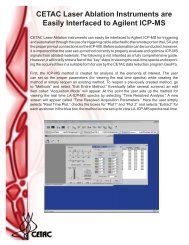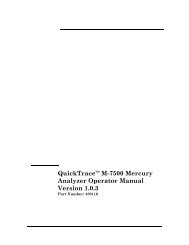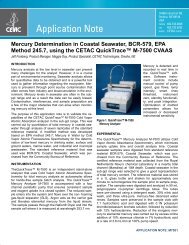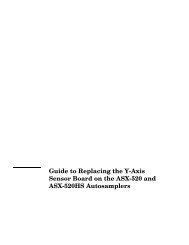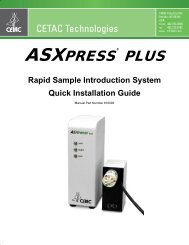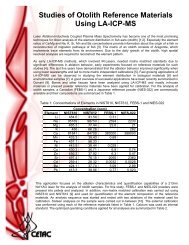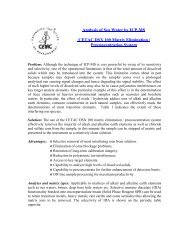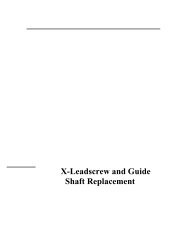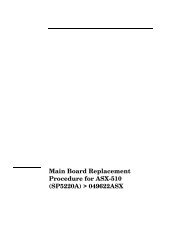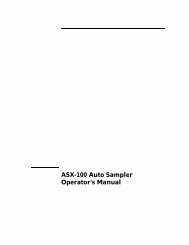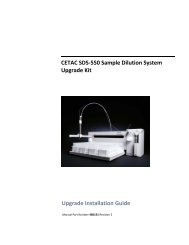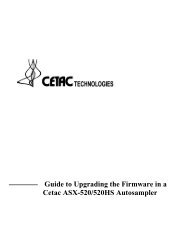CETAC M-7600 Mercury Analyzer Operator's Manual
CETAC M-7600 Mercury Analyzer Operator's Manual
CETAC M-7600 Mercury Analyzer Operator's Manual
You also want an ePaper? Increase the reach of your titles
YUMPU automatically turns print PDFs into web optimized ePapers that Google loves.
Operator’s <strong>Manual</strong><br />
Chapter 5: Maintaining the <strong>Mercury</strong> <strong>Analyzer</strong><br />
exhaust.” If liquid has passed through the system, then proceed with the below<br />
corrective action steps.<br />
3 Remove the sample cell, GLS, and Perma Pure ® cartridge (with all tubing still<br />
attached). Place all parts on a clean lab cloth (or equiv.) on the lab bench.<br />
4 Dismantle the sample cell completely. See page 109.<br />
CAUTION<br />
Do NOT remove the cell window blocks over the optical rail if the cell is wet or full<br />
of water. Do this instead outside the instrument to avoid spillage onto the optical<br />
components.<br />
5 Dump out all water and brine from the sample cell glass tube.<br />
6 Rinse the sample cell glass tube with deionized water and oven dry.<br />
Alternatively, dry by rinsing with alcohol (recommended spectophotometric<br />
isopropyl alcohol (isopropanol)) and blowing dry with clean air, nitrogen, or<br />
argon.<br />
You can supply drying gas from the argon carrier gas source by simply<br />
disconnecting the instrument gas supply and turning down the gas pressure to<br />
create a low flow.<br />
WARNING<br />
The flow used for drying of the optical components must be less than 100<br />
mL/min or extremely low psig such as < 5 psi. If a flow greater than this is<br />
used, the gas could blow the optical parts from your grip and cause<br />
personal injury.<br />
7 Rinse and all remaining cell holder parts, fittings and transfer tubing with<br />
deionized water. Dry these parts by rinsing with alcohol (recommended<br />
spectophotometric isopropyl alcohol (isopropanol)) and blowing dry with<br />
clean air, argon, or nitrogen. Inspect closely to be sure all water, and/or all<br />
residual alcohol is completely eliminated from all fittings, tubes, parts, and gas<br />
ports.<br />
When you re-assemble the cell components and install the cleaned cells, use<br />
new or clean, dry reference and sample cell tubing.<br />
CAUTION<br />
Do not oven dry any of the parts except for the sample cell glass tube. Instead, use<br />
the alcohol rinse/blow-dry procedure. Excessive heat could damage these parts.<br />
8 Clean the sapphire window first with water and then as described on page<br />
109.<br />
9 Reassemble the window and cell end caps. Handle the window with clean<br />
forceps or hold by the edge with fingertips while wearing gloves (verify<br />
cleanliness by inspection with low-angle room light reflection).<br />
10 Install the glass tube into the cell end caps, and seat firmly to fully engage both<br />
O-rings.<br />
120



